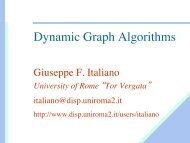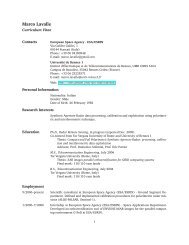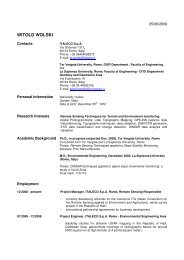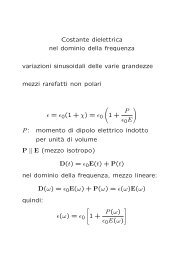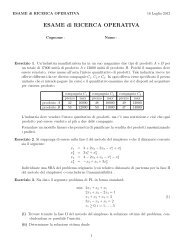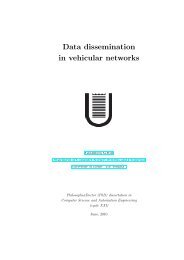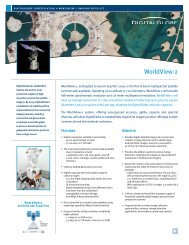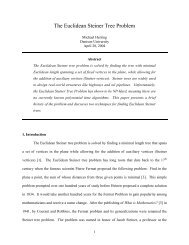- Page 1: TOR VERGATA UNIVERSITY Department o
- Page 4 and 5: ―Office‖ in ESRIN: Annekatrien
- Page 6 and 7: 2. Used dataset ___________________
- Page 8 and 9: 7. Application of automatic classif
- Page 10 and 11: 2 Abstract of the VHR imagery with
- Page 12 and 13: 4 The retrieval of information in u
- Page 14 and 15: 6 The retrieval of information in u
- Page 16 and 17: 8 The retrieval of information in u
- Page 18 and 19: 10 The retrieval of information in
- Page 20 and 21: 12 Automatic classification of Very
- Page 22 and 23: 14 Automatic classification of Very
- Page 26 and 27: 18 Automatic classification of Very
- Page 28 and 29: 20 Automatic classification of Very
- Page 30 and 31: 22 Where: Automatic classification
- Page 32 and 33: 24 Automatic classification of Very
- Page 34 and 35: 26 Automatic classification of Very
- Page 36 and 37: 28 1.5.1.1 GLCM Automatic classific
- Page 38 and 39: 30 Automatic classification of Very
- Page 40 and 41: 32 Automatic classification of Very
- Page 42 and 43: 34 Used dataset 2.1 QuickBird Quick
- Page 44 and 45: 36 Used dataset Figure 2.2: A QB im
- Page 46 and 47: 38 Used dataset Figure 2.3: A QB im
- Page 48 and 49: 40 Used dataset Figure 2.4: A QB im
- Page 50 and 51: 42 Used dataset Figure 2.5: AHS sys
- Page 52 and 53: 44 Used dataset Figure 2.6: AHS ima
- Page 54 and 55: 46 Used dataset The image belongs t
- Page 56 and 57: 48 Used dataset
- Page 58 and 59: 50 Methodology 3.1 First tests and
- Page 60 and 61: 52 Methodology Fig.3.1: MIVIS RGB 2
- Page 62 and 63: 54 Methodology 3.2 The mixed approa
- Page 64 and 65: 56 Methodology Fig 3.2: example of
- Page 66 and 67: 58 Methodology results and it was p
- Page 68 and 69: 60 Methodology where quant_levels r
- Page 70 and 71: 62 Methodology starting one from th
- Page 72 and 73: 64 Methodology
- Page 74 and 75:
66 Pre-processing 4.1 Atmospheric c
- Page 76 and 77:
68 Pre-processing 4.1.1 The FLAASH-
- Page 78 and 79:
70 Pre-processing 4.1.1.1. Atmosphe
- Page 80 and 81:
72 Pre-processing 4.1.2.2 Input par
- Page 82 and 83:
74 Pre-processing With the option a
- Page 84 and 85:
76 Pre-processing 4.1.3 Atmospheric
- Page 86 and 87:
78 Pre-processing The signatures im
- Page 88 and 89:
80 Pre-processing 4.2.1 Simulated r
- Page 90 and 91:
82 Pre-processing where the first t
- Page 92 and 93:
84 Pre-processing Fig. 4.5: solar r
- Page 94 and 95:
86 Pre-processing Fig. 4.6: AHS fal
- Page 96 and 97:
88 Pre-processing Fig 4.8: AHS real
- Page 98 and 99:
90 Pre-processing
- Page 100 and 101:
92 5.1 Vegetation Spectral, textura
- Page 102 and 103:
94 5.2 Water Spectral, textural and
- Page 104 and 105:
96 5.3 Bare Soil Spectral, textural
- Page 106 and 107:
98 5.4 Buildings Spectral, textural
- Page 108 and 109:
100 5.5 Roads Spectral, textural an
- Page 110 and 111:
102 Spectral, textural and shape ch
- Page 112 and 113:
104 Spectral, textural and shape ch
- Page 114 and 115:
106 Pixel based classification of V
- Page 116 and 117:
108 Pixel based classification of V
- Page 118 and 119:
110 Pixel based classification of V
- Page 120 and 121:
112 Pixel based classification of V
- Page 122 and 123:
114 Pixel based classification of V
- Page 124 and 125:
116 Pixel based classification of V
- Page 126 and 127:
118 Reflectance Reflectance 0,45 0,
- Page 128 and 129:
120 Pixel based classification of V
- Page 130 and 131:
122 Pixel based classification of V
- Page 132 and 133:
124 Pixel based classification of V
- Page 134 and 135:
126 Pixel based classification of V
- Page 136 and 137:
128 Reflectance Pixel based classif
- Page 138 and 139:
130 Pixel based classification of V
- Page 140 and 141:
132 Pixel based classification of V
- Page 142 and 143:
134 Pixel based classification of V
- Page 144 and 145:
136 Pixel based classification of V
- Page 146 and 147:
138 Pixel based classification of V
- Page 148 and 149:
140 Pixel based classification of V
- Page 150 and 151:
142 6.4.4 Bari (I) Pixel based clas
- Page 152 and 153:
144 Pixel based classification of V
- Page 154 and 155:
146 Pixel based classification of V
- Page 156 and 157:
148 Pixel based classification of V
- Page 158 and 159:
150 Application of automatic classi
- Page 160 and 161:
152 Application of automatic classi
- Page 162 and 163:
154 Application of automatic classi
- Page 164 and 165:
156 Application of automatic classi
- Page 166 and 167:
158 Application of automatic classi
- Page 168 and 169:
160 Application of automatic classi
- Page 170 and 171:
162 Application of automatic classi
- Page 172 and 173:
164 Application of automatic classi
- Page 174 and 175:
166 Application of automatic classi
- Page 176 and 177:
168 Conclusions Conclusions In this
- Page 178 and 179:
170 Conclusions In fact, the traini
- Page 180 and 181:
172 Conclusions (i.e. topological r
- Page 182 and 183:
174 Bibliography [10] P. M. Teillet
- Page 184 and 185:
176 Bibliography [102] Geoeye, Ikon
- Page 186 and 187:
178 Bibliography [122] P. Dreyer,
- Page 188 and 189:
180 Bibliography [141] P. Gong, D.
- Page 190 and 191:
182 Bibliography [160] B. Guindon,
- Page 192 and 193:
184 Bibliography [307] F. Melgadi a
- Page 194 and 195:
186 Bibliography [407] Z. Qu, B. Ki
- Page 196 and 197:
188 Bibliography [424] C. Elachi,
- Page 198 and 199:
190 Bibliography [709] A. R. Gilles
- Page 200 and 201:
192 Bibliography
- Page 202 and 203:
194 List of acronyms and abbreviati
- Page 204 and 205:
196 CV, conferences and publication





